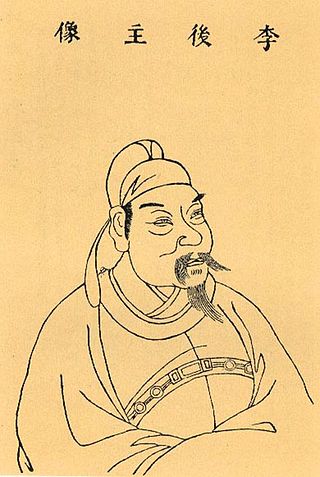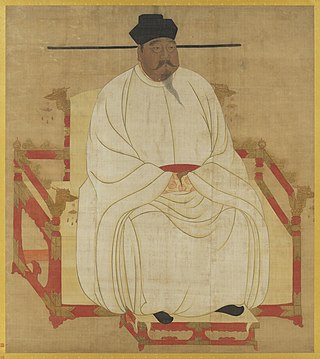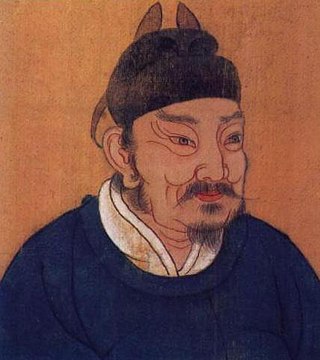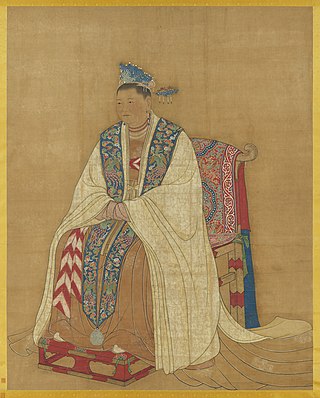
Li Yu, before 961 known as Li Congjia (李從嘉), also known as Li Houzhu or Last Lord of Southern Tang (南唐後主), was the third ruler of the Southern Tang dynasty of China during the Five Dynasties and Ten Kingdoms period. He reigned from 961 until 976, when he was captured by the invading Northern Song dynasty armies which annexed his state.

Emperor Taizu of Song, personal name Zhao Kuangyin, courtesy name Yuanlang, was the founding emperor of the Song dynasty of China. He reigned from 960 until his death in 976. Formerly a distinguished military general of the Later Zhou dynasty, Emperor Taizu came to power after staging a coup d'état and forcing Emperor Gong, the last Later Zhou ruler, to abdicate the throne in his favor.

The Historical Records of the Five Dynasties is a Chinese history book on the Five Dynasties period (907–960), written by the Song dynasty official Ouyang Xiu in private. It was drafted during Ouyang's exile from 1036 to 1039 but not published until 1073, a year after his death. An abridged English translation by Richard L. Davis was published in 2004.
The Old History of the Five Dynasties was an official history mainly focusing on Five Dynasties era (907–960), which controlled much of northern China. And it also includes some history of other south states during the era. It was compiled by the Song dynasty official-scholar Xue Juzheng in the first two decades of the Song dynasty, which was founded in 960. It is one of the Twenty-Four Histories recognized through Chinese history.

Guo Wei, also known by his temple name as the Emperor Taizu of Later Zhou (後周太祖), was the founding emperor of the Chinese Later Zhou dynasty during the Five Dynasties and Ten Kingdoms period, reigning from 951 until his death in 954.

Chai Rong, later known as Guo Rong (郭榮), also known by his temple name as the Emperor Shizong of Later Zhou, was the second emperor of the Later Zhou dynasty of China, during the Five Dynasties and Ten Kingdoms period. He reigned from 954 until his death in 959. He succeeded his uncle-in-law Guo Wei, whose surname he had adopted.

Zhou, known as the Later Zhou in historiography, was a short-lived Chinese imperial dynasty and the last of the Five Dynasties that controlled most of northern China during the Five Dynasties and Ten Kingdoms period. Founded by Guo Wei, it was preceded by the Later Han dynasty and succeeded by the Northern Song dynasty.
Guo Zhongshu, courtesy name Shuxian, was a Chinese painter, scholar, calligrapher and philologist during the Five Dynasties period and Song dynasty. He was noted for his paintings of landscapes and structures.
Li Yixing (李彝興), né Li Yiyin (李彝殷), formally the Prince of Xia (夏王), was an ethnically-Dangxiang warlord of the Chinese Five Dynasties and Ten Kingdoms Period and the early Song Dynasty, ruling Dingnan Circuit from 935 to his death in 967, as its military governor (Jiedushi) in de facto independence.

Empress Dowager Du was an empress dowager of imperial China's Song dynasty. She was the wife of general Zhao Hongyin and the mother of Emperor Taizu of Song, who founded the Song dynasty.
Wudai Huiyao is a Chinese historiography book on the Five Dynasties period of ancient China, written by the Song dynasty chancellor Wang Pu (922–982), who had personally served the last two of the five dynasties, namely the Later Han and the Later Zhou.
Empress Fu, posthumously Empress Xuanyi (宣懿皇后) was an empress consort of the Chinese Later Zhou dynasty during the Five Dynasties and Ten Kingdoms period. She was invested the empress in 954 when her husband Guo Rong became the second Later Zhou emperor. Three years after her death, Guo Rong married her younger sister when he fell critically ill.
Wang Jun was one of the first chancellors of imperial China's short-lived Later Zhou during the Five Dynasties and Ten Kingdoms period. He started his career as a singer for those in power, and rose to high prominence due to his association first with military general Liu Zhiyuan, founder of the Later Han, and later Guo Wei, who founded Later Zhou. After becoming the Later Zhou chancellor, his excessive actions gradually created a lot of distrust in Guo, culminating in his precipitous political downfall right before his death.
Liu Min, named Liu Chong before 951,, also known by his temple name as the Emperor Shizu of Northern Han, was the founding emperor of the Northern Han dynasty of China during the Five Dynasties and Ten Kingdoms period. He was an ethnic Shatuo and the younger brother of the Later Han dynasty's founder Liu Zhiyuan.
Li Cunxin (李存信) (862–902), originally Zhang Wuluo (張污落), was a military general in imperial China's Tang dynasty, serving the Shatuo military leader Li Keyong, who adopted him as a son.
Li Cunzhang (李存璋) was a military general in imperial China's Tang dynasty, and later the Jin territory in the ensuing Five Dynasties and Ten Kingdoms period after Tang's collapse. He served the Shatuo leaders Li Keyong — who adopted him as a son — and Li Keyong's biological son and successor Li Cunxu.
Li Cunjin (李存進), originally Sun Chongjin (孫重進), was a military general in imperial China's Tang dynasty, and later the Jin territory in the ensuing Five Dynasties and Ten Kingdoms period after Tang's collapse. He served the Shatuo leaders Li Keyong — who adopted him as a son — and Li Keyong's biological son and successor Li Cunxu. He died in the battles against Zhang Chujin.
Zhao Jingyi was a general of the Chinese Five Dynasties and Ten Kingdoms Period state Later Tang, serving as one of Li Siyuan 's chiefs of staff (Shumishi) from 928 to 929.
Empress Fu was an empress consort and empress dowager during the Later Zhou dynasty. She was a daughter of general Fu Yanqing and a younger sister of Empress Xuanyi, who was married to the Later Zhou emperor Guo Rong from 951 or so to 956. Guo Rong had been without a wife ever since Empress Xuanyi's death in 956, and he married the younger Fu in July 959 when he fell critically ill. The marriage was clearly political and most likely not consummated: Guo Rong died 10 days later and was succeeded by his 6-year-old son Guo Zongxun. Empress Dowager Fu as his guardian became the regent.
Liu Ji'en, also known in historiography as Shaozhu of Northern Han , was the third emperor of China's Northern Han dynasty during the Five Dynasties and Ten Kingdoms period. He ruled for 60 days in 968 before being killed.






